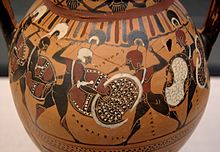Tyrrhenian amphorae

Tyrrhenian amphorae are a special form of Attic - black- necked amphorae .
Tyrrhenian amphorae were only used for a short period of time, between about 565 and 550 BC. Chr., Produced. They are egg-shaped and stand out due to their special decoration. The handle is usually decorated with a lotus palmette cross or a plant loop. In addition, the end is always provided with a red painted ridge.
The amphora body is decorated with several friezes. Above all, the top of the friezes, the shoulder frieze, has mostly striking motifs. A mythological event is often shown, but the first erotic motifs can also be found in Attic vase painting. The representation of the sacrifice of Polyxena is unique, like some other representations. Often the figures were described by inscriptions . The other, mostly two to three, friezes are often decorated with animals. A frieze can be replaced by a plant band.

The animal friezes and the colors of the vases are reminiscent of Corinthian models. It is likely that Attic potters copied Corinthian models in this case in order to better sell these vases to Etruria . The Athenians made the market leaders from Corinth competition on the Etruscan market. It was based on the wishes of the Etruscans, who valued neck amphorae and color. However, only a few neck amphoras were produced in Corinth.
Thus, the Athenians apparently took advantage of a niche in the market . Similar vases were also made by the Etruscans. Most of the almost 200 Tyrrhenian amphorae known today were also found in Etruria. Early vase painters who painted Tyrrhenian amphorae included the Castellani Painter and the Goltyr Painter , while the later representatives were the Prometheus Painter and the Kyllenios Painter . The Tyrrhenian group was named after this type of vase.
The British archaeologist Tom Carpenter came to the conclusion in 1983 in his essay "On the Dating of the Tyrrhenian Group", based on iconographic and epigraphic considerations, that the amphorae should be dated to the period between 550 and 530. In addition, he thinks it is possible that the vases were not produced in Athens, but in northern Attica or even outside of Attica.
Individual evidence
- ↑ Oxford Journal of Archeology , 2, pp. 279-293.
literature
- Thomas Mannack : Greek vase painting. An introduction. Theiss, Stuttgart 2002, ISBN 3-8062-1743-2 , pp. 117f.